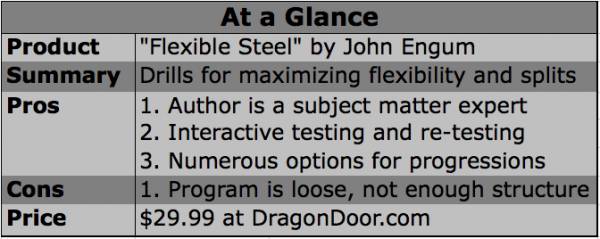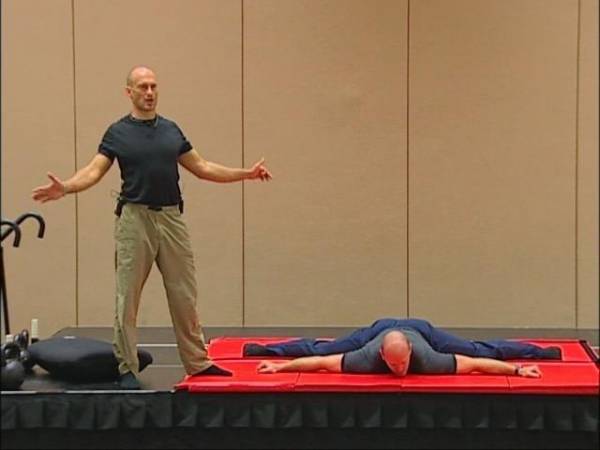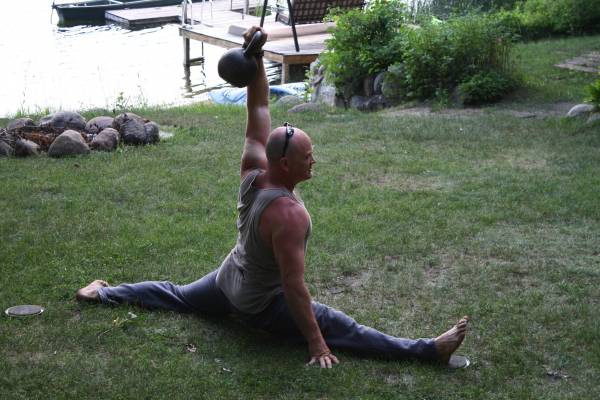
Jon Engum’s Flexible Steel delivers much needed insight into flexibility with authority and real results. There’s no surplus of flexibility in our population these days. Furthermore, I’d argue even those who are in training or performance practices that demand flexibility are often lacking in the ability. To remedy this problem, Jon Engum steps in as an experienced coach with a pedigree and performance markers that can garner your attention.
 It won’t take long for you to be convinced of Engum’s expertise. For a simpleton like myself, the picture of him in the book at the bottom of the splits with a 2-pood kettlebell locked out overhead did the trick. If you’re still skeptical, Jon is a Grandmaster with a seventh degree black belt in Taekwando. He’s also a fourth degree black belt in both Hapkido and Kumdo and is a Master RKC instructor. Combining his own real world experience with that of a life-changing set of experiences with the author of Relax into Stretch and Super Joints, Pavel Tsatsouline, Engum delivers a flexibility protocol that makes bold claims and delivers.
It won’t take long for you to be convinced of Engum’s expertise. For a simpleton like myself, the picture of him in the book at the bottom of the splits with a 2-pood kettlebell locked out overhead did the trick. If you’re still skeptical, Jon is a Grandmaster with a seventh degree black belt in Taekwando. He’s also a fourth degree black belt in both Hapkido and Kumdo and is a Master RKC instructor. Combining his own real world experience with that of a life-changing set of experiences with the author of Relax into Stretch and Super Joints, Pavel Tsatsouline, Engum delivers a flexibility protocol that makes bold claims and delivers.
Right away, Engum knows he’s got to win over skeptics. The text, then, starts with a simple test of rotational flexibility. He asks you to stand with your feet rooted in the ground with locked out knees. He then asks you to rotate maximally from the trunk and mark your rotational flexibility with a visual marker. Then Engum gives specific cues to retest, not once but twice. Both times I experienced marked improvement.
Still skeptical, I was forced to read on. Here Engum lays the foundation of the text with the Three Big S’s of Stretching: strength, space, and spread. Simply put, strength in this context seeks to utilize strength over gravity to achieve greater ranges of motion, while space looks to demonstrate flexibility by creating space between joints rather than “jam one joint into another.” Lastly, spread refers to an ability to defuse movement over a larger area in the body rather than achieve range of motion from one focal point.
Engum’s flexibility training begins with mobility drills, which claim to aid in creaky joints and even reverse arthritic symptoms. From this general movement prescription, Engum gets specific as he introduces “The Frog” and leads into the splits in the next few chapters. The nitty-gritty of the splits development section of the program involves a series of drills pulled from all the corners of Engum’s knowledge, from solo practice at the beach to partner drills to the use of kettlebells and heavy bags. After addressing a variety of tactics to achieve better side splits, Engum begins to introduce front splits. It’s here that skill transfer drills, like a calf stretch and a kettlebell aided hamstring stretch, for example, help build competency for the front split.
 With all the movements and progressions having been addressed, Engum touches on two powerful points in closing the text. The first, more straightforward bit of advice is the use of water as a tool to improve flexibility. Literally, training in water provides a gateway to more remarkable results. And lastly, I thought an incredible point Engum makes it to avoid living in the stance of our sport. Fighters for example operate in constant flexion. Crouched and ready to spring, these athletes often take this posture with them outside of their sport. Balance is critical in our biomechanical habits, and Engum’s point about not living in our fighting stance is duly noted. As a matter of fact, Engum’s “Escape Your Fighting Stance” program could be used as a stand-alone program.
With all the movements and progressions having been addressed, Engum touches on two powerful points in closing the text. The first, more straightforward bit of advice is the use of water as a tool to improve flexibility. Literally, training in water provides a gateway to more remarkable results. And lastly, I thought an incredible point Engum makes it to avoid living in the stance of our sport. Fighters for example operate in constant flexion. Crouched and ready to spring, these athletes often take this posture with them outside of their sport. Balance is critical in our biomechanical habits, and Engum’s point about not living in our fighting stance is duly noted. As a matter of fact, Engum’s “Escape Your Fighting Stance” program could be used as a stand-alone program.
As someone with enough flexibility to remain functional in the movements that I practice, I feel like my sense of urgency around the topic of flexibility is lacking. However, this lack of urgency is to my own detriment. I have a clear picture of which areas I struggle in and my seemingly annual bout with a hip problem is due in large part to specific areas of immobility. Engum’s work is universally relevant, in my opinion. His program will outline tools to help nearly anyone achieve greater flexibility.
It’s worth noting, however, that the program is biased towards the fighting community and the splits, specifically. Given that the reader is motivated and in search of such results, Engum can provide it. The text may be a bit too loose to many folks that need specific structure in their programming, though. All and all, this was a learning experience from a person with the authority to teach it.
Flexible Steel is available at Dragondoor.com for $29.95
Learn more about Jon’s system by trying his four weeks of free workouts.






